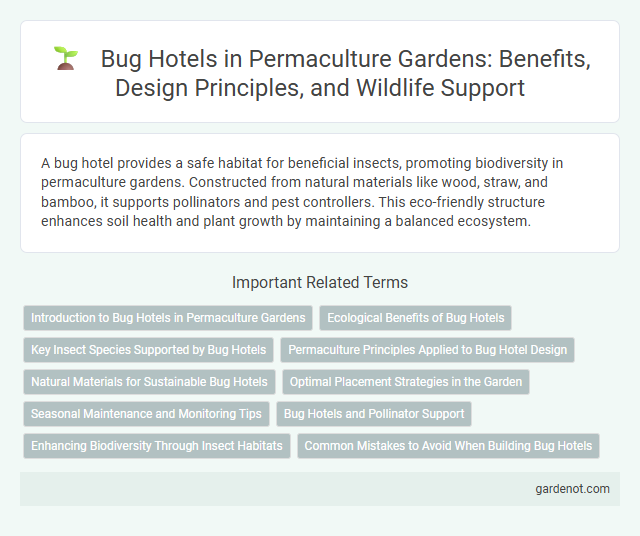A bug hotel provides a safe habitat for beneficial insects, promoting biodiversity in permaculture gardens. Constructed from natural materials like wood, straw, and bamboo, it supports pollinators and pest controllers. This eco-friendly structure enhances soil health and plant growth by maintaining a balanced ecosystem.
Introduction to Bug Hotels in Permaculture Gardens
Bug hotels serve as essential habitats for beneficial insects, promoting biodiversity and natural pest control in permaculture gardens. These structures are crafted from organic materials like wood, straw, and bark to attract pollinators, predators, and decomposers that enhance soil health and plant growth. Integrating bug hotels into permaculture design supports ecological balance, reduces reliance on chemical pesticides, and fosters resilient garden ecosystems.
Ecological Benefits of Bug Hotels
Bug hotels enhance biodiversity by providing essential habitat for beneficial insects such as pollinators and natural pest controllers, promoting a balanced ecosystem. These structures support soil health and plant growth by encouraging decomposition and nutrient cycling through the presence of decomposer species. Integrating bug hotels into permaculture design reduces the need for chemical pesticides, fostering sustainable and eco-friendly gardening practices.
Key Insect Species Supported by Bug Hotels
Bug hotels provide essential habitats for key insect species such as solitary bees, ladybugs, and lacewings, which contribute to effective pollination and natural pest control. Solitary bees enhance crop yields through efficient pollination, while ladybugs and lacewings prey on aphids and other harmful pests, maintaining ecological balance. These habitats support biodiversity and promote sustainable gardening practices by fostering populations of beneficial insects.
Permaculture Principles Applied to Bug Hotel Design
Bug hotel design integrates permaculture principles by creating habitats that mimic natural ecosystems, promoting biodiversity and natural pest control. Utilizing locally sourced, natural materials enhances sustainability while providing shelter for beneficial insects like ladybugs and solitary bees that support pollination and soil health. Strategic placement within gardens encourages ecological balance, reinforcing the principle of cooperating rather than competing with nature.
Natural Materials for Sustainable Bug Hotels
Sustainable bug hotels rely on natural materials such as bamboo, straw, dead wood, and dried leaves to create habitats that support beneficial insects like solitary bees and ladybugs. Using untreated wood and organic components ensures a chemical-free environment that promotes biodiversity and pest control in permaculture gardens. These materials also provide insulation and moisture regulation, fostering a healthy refuge that encourages insect pollination and natural pest management.
Optimal Placement Strategies in the Garden
Optimal placement of a bug hotel involves situating it in a sheltered, sunny spot close to flowering plants and diverse vegetation to attract beneficial insects such as ladybugs and solitary bees. Positioning near compost heaps or vegetable beds enhances natural pest control and pollination efficiency. Elevating the structure slightly off the ground prevents moisture buildup, ensuring a longer-lasting habitat for beneficial garden insects.
Seasonal Maintenance and Monitoring Tips
Regularly inspect bug hotels each season to remove debris and check for damage, ensuring a safe habitat for beneficial insects like ladybugs and solitary bees. Replace or add fresh natural materials such as straw, wood, and hollow stems to maintain optimal shelter conditions and encourage diverse insect populations. Monitor moisture levels and exposure to sunlight to prevent mold growth and promote a thriving ecosystem throughout the year.
Bug Hotels and Pollinator Support
Bug hotels provide essential habitats for beneficial insects, promoting biodiversity and supporting pollinator populations such as bees, butterflies, and ladybugs. These structures are designed using natural materials like wood, straw, and bamboo to offer shelter and breeding spaces critical for pollinators' survival in permaculture gardens. Enhancing pollinator support through bug hotels increases crop yields and ecosystem resilience by facilitating effective pollination and pest control.
Enhancing Biodiversity Through Insect Habitats
Bug hotels provide essential habitats for beneficial insects such as ladybugs, bees, and lacewings, which play crucial roles in pollination and natural pest control. Incorporating diverse materials like wood, straw, and hollow stems creates microhabitats that support various insect species, enhancing overall ecosystem health. Establishing multiple bug hotels throughout a permaculture garden fosters increased biodiversity and strengthens ecological balance.
Common Mistakes to Avoid When Building Bug Hotels
Common mistakes to avoid when building bug hotels include using treated wood or synthetic materials that can be harmful to insects, as these reduce habitat suitability and chemical exposure risks. Overpacking the compartments limits airflow and moisture control, leading to mold growth and discouraging insect habitation. Placing the bug hotel in an unsuitable location, such as in full shade or overly exposed areas, fails to provide the necessary microclimate for diverse beneficial insects.
Bug hotel Infographic

 gardenot.com
gardenot.com